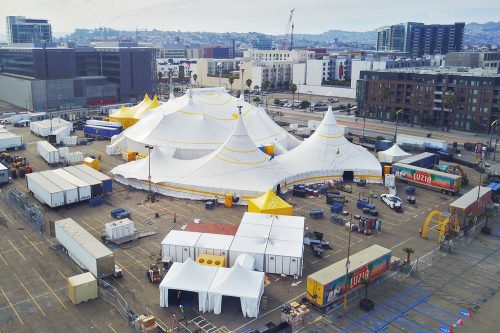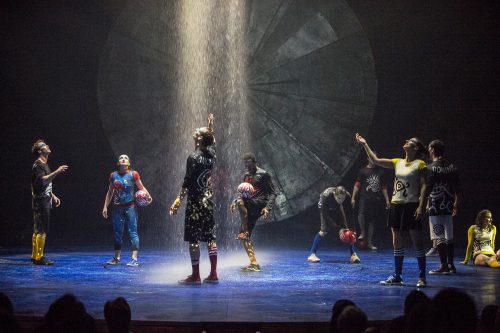If you’ve ever seen Cirque du Soleil’s fantastic Las Vegas show O, you no doubt marveled at the complexity of performances taking place in and out of water, and the way the show’s creators managed to make a large tank appear and disappear as needed.
Now imagine incorporating that complexity in one of the famous Montreal circus company’s traveling acts, and you’re ready to take in Luzia, its newest, and perhaps most ambitious road show ever.
Debuting in the United States this week in San Francisco—like many traveling Cirque shows, it opened initially in Montreal and Toronto—Luzia is described as a “waking dream” of Mexico, “a wondrous world that inspires you to explore your senses, enveloped in light and nurtured by rain.”
Founded in 1984, Cirque du Soleil is now a global powerhouse with 21 different shows worldwide, including nine on tour and eight in Las Vegas alone. There’s no doubt that descriptions of its shows are often difficult for the average person to parse—in truth, many people enjoy Cirque performances simply for the terrific acrobatics, soulful music, and even the clowns, and not because of its charming, but often inscrutable backstories.
Although the Cirque’s touring effort, Amaluna, incorporates what is essentially a human-sized bowl of water, Luzia’s creators decided early on that the new production would become Cirque’s largest-ever traveling water show, Marshall Spratt, the show’s assistant technical director, told Fast Company.
Of Luzia’s 12 acts, four—or fully one third—utilize water in one way or another. There’s a 3,000-liter pool built under its stage, and a system that effectively rains on the performers, with images appearing in that water curtain thanks to a computer-controlled system.
Benjamin Courtenay, a 23-year-old Canadian solo artist who performs above and in the water in Luzia, said the show is the first time he’d worked with water, and that learning to do so presented a challenge.
Courtenay explained that the water made the stage a bit slippery and that he’d had to be very conscious of how he moved. He’d initially been worried that his hands might slip from the loops at the end of the straps he swings from. But in the months since Luzia was conceived, he’s overcome those fears.
“This is some of the most fun I’ve had,” he said. “I like working with something that’s a challenge, or that’s different. I don’t like getting too comfortable. I like something that makes me be there, [makes me] be present.”
A LOT OF MAINTENANCE
It’s one thing to maintain a water tank like the one used in the Cirque’s O, permanently installed at the Bellagio. It’s quite another to make sure that a traveling system is kept in working order and safe for everyone involved.
According to Spratt, Cirque’s leadership has learned a number of things from O and Amaluna over the years that were critical to making sure it was possible to incorporate water as tantamount to a central character in Luzia.
It begins with a check first thing every morning, and last thing at night, to make sure the water system is working properly—that the temperature is holding steady, that the chemical balance is correct, that pressure is right, and that UV filters are doing their job. There’s also a full system check once a week, Spratt said.
At any given moment, the pool under the stage holds about 3,000 liters, while a tank in a shipping container behind Luzia’s big top holds another 3,000. All that water comes from city resources, and as water is used and discarded, it is diverted into the show’s grey water systems for things like its public toilets to minimize waste. All told, Spratt said, Luzia adds a few hundred liters a day.
What’s most important, Spratt emphasized, is that the system is safe for everyone involved—from the performers who work in and around the water to the audience members who sometimes get a little bit wet. No one wants anyone to get sick from exposure to unclean water—and to date, no one has, he said.
Still, if there were numerous simultaneous system failures, it’s possible to imagine that the show’s directors would conclude they have to yank the water element and continue without them. In that sense, Spratt pointed out, it would be much like if Luzia’s jugglers were unavailable—there’s always a contingency plan for continuing without a character if necessary. After all, with tens of thousands of tickets sold and nine performances a week, the show very much does have to go on.
So far, though, everything’s been fine, and that means there’s room for a little humor.
Inside the shipping container where the show’s 3,000-liter tank sits, it’s a tight fit. The large pipes that go in and out of the tank are very warm, and alongside a couple of gallon jugs of chlorine there’s boxes of used filters that would look familiar to anyone with a jacuzzi.
In fact, Spratt notes that on more than one occasion, he’s dipped his feet in the warm water inside the tank. If you picture some chill music playing in the background, you can almost imagine the crew hanging out here as if it was a hot tub.
So, Spratt joked, “I have to keep the techs from drinking beer in here.”
{ SOURCE: FastCompany | https://goo.gl/qDwkko }


